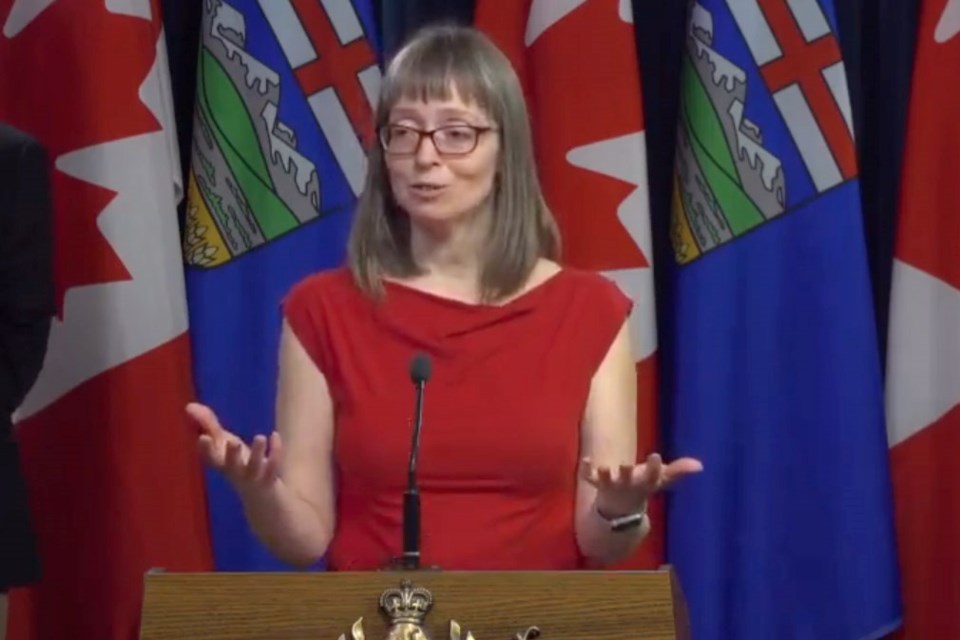ALBERTA – Changes are coming to COVID-19 coronavirus testing in the province to better understand how the virus is moving through Alberta.
Alberta Chief Medical Officer of Health Dr. Deena Hinshaw announced Monday (March 23) that new protocols to testing capacity in the province are being implemented to capture those who are at risk of community transmission.
“COVID-19 does not discriminate, all of us need to be vigilant,” Hinshaw said.
As of Monday, there were 42 new cases in Alberta, bringing the provincial total to 301 confirmed cases. Of the confirmed cases, 11 may be a result of community transmission, 18 individuals have been hospitalized and seven patients are in intensive care units.
There have been no additional COVID-19 deaths recorded in the province and three patients have fully recovered.
The biggest concern in the province is the threat of community transmission of the virus, Hinshaw said, explaining the numbers of reported COVID-19 cases will shift over the next few weeks based on the testing changes and measures of protection introduced by the province over the past week.
“At this point, we’re using our testing capacity to focus on that issue of local transmission,” Hinshaw said, explaining that this data will be used to locate geographical locations of concern and potential areas where the virus may peak to guide responses to COVID-19 in the province.
Hinshaw added that testing will also be added for health care workers later this week.
Moving forward the province will continue testing that has been in place of those admitted to hospitals with respiratory illness and residents of continuing care and similar facilities.
“We should expect that there will be additional new cases that we will see because we’re still seeing after-effects of exposures that happened two weeks ago,” Hinshaw said.
“This is clearly a very contagious illness, it’s something that nobody has immunity to and so we need to closely monitor those community-acquired numbers.”
The measures that are being put in place do not make the virus go away, Hinshaw said, explaining they work to slow down the rate of spread, which in turn helps to prevent a steep peak of everyone getting sick at once and overwhelming the health care system.
Hinshaw said these changes to testing are not expected to lower the capacity of daily testing in the province.
“I anticipate we will be using are full lab capacity going forward with this new shift,” Hinshaw said, adding they are continuing to refine the testing policy in the province to ensure the lab is used to full capacity in the most strategic way possible.
Alberta has one of the best COVID-19 testing capacities in the world, with a maximum of 3,000 tests a day, Hinshaw said.
She added it is unlikely they will reach the capacity to test all Albertans, even those with mild symptoms.
“I understand some Albertans may be upset with this change. I can appreciate the comfort and certainty that testing can bring for those unsure if they have a minor bug or COVID-18,” Hinshaw said.
Physical distancing is more important than ever to ensure those infected with COVID-19 do no overwhelm the health care system in the province, Hinshaw said.
To help prevent the spread of the virus, returning travellers should be at home isolating for two weeks upon their return. If they experience mild symptoms they are required to self-isolate for another minimum of 10 days, or until symptoms are resolved.
“The most up-to-date medical evidence indicates that if you are feeling well from the onset of mild symptoms like sore throat, runny nose or cough, you will be able to stop self-isolating – provided your symptoms have resolved,” Hinshaw said.
If symptoms continue past 10 days, there is a need to continue self-isolation. Hinshaw said self-isolation for 14 days is still necessary based on exposure, travel dates, or for those who have had an exposure of concern.
This new approach has been adopted in other provinces and promotes the idea of self-isolation as a way to contain the virus, Hinshaw said, adding it is important to remember the majority of people who get COVID-19 will experience minor symptoms.
Along with these changes, Alberta Health Service is taking steps to minimize transmission and provide safe and timely care, Hinshaw said. Staff physicians, nurses and contractors will be screened before each shift at all hospitals, she said, and any employee deemed to be a health risk will be asked to return home self-isolate.
A process has also been introduced by Alberta Health Services to expedite the return of workers who are isolating, but displaying no symptoms. This step will only be taken in exceptional and limited circumstances where the return of a front-line health care worker is essential because no other alternatives for coverage are available.
“This is necessary to keep both our patients and health care workers safe,” Hinshaw said.







